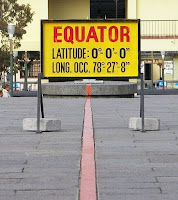Twice a year, during the spring and autumn equinoxes, the sun passes directly over the Equator, but equatorial regions often have little seasonal variation. Many equatorial locations have only wet and dry seasons. Oddly, humid weather means that equatorial regions are not the hottest in the world even though they are among the closest to the sun. The water in the equatorial air cools it slightly.
Not all equatorial regions are hot and humid. Mount Kilimanjaro, Tanzania, is only 205 miles from the Equator, but its elevation creates a climate with cool, dry weather and even glaciers. The Andes are another region lacking the hot, humid climate. The mountain range includes a desert with almost no rain as well as some of the tallest peaks on Earth.
The highest point on the equator is the south slopes of Volcán Cayambe in Ecuador at 15387 feet and it has a permanent snow cap.
According to journal of the American College of Allergy, Asthma and Immunology if you live at or near the equator, you are at higher risk of getting asthma and other breathing related allergies because people living near the equator have a high risk of ultraviolet –B exposure from sun rays. This exposure can effect their immune system making them prone to allergies.
Only twenty percent of the world's population lives below the equator. There are more countries in northern hemisphere than southern hemisphere, but what really gives the north the edge are the highly populated countries like China, India, and USA. Only two out of the top ten populated countries lie south of the Equator: Brazil and Indonesia.
Alert, in the Qikiqtaaluk Region, Nunavut, Canada is the northernmost permanently inhabited place in the world, 508 miles from the North Pole. Its permanent population was reported as zero in the 2011 census, but military and scientific personnel on rotation live there. Alert has what is called a nautical polar night—where 24 hours are in effect completely dark with only a marginal astronomical twilight—which occurs from November 19 to January 22. Days and nights are 12 hours each at the equator...no long or short days and nights.
Twilight is shorter at the Equator because at low latitudes, the sun sets perpendicular to the horizon, while at higher latitudes, the sun can set at a more oblique angle, allowing it to remain close to the horizon after sunset for a longer period of time.
The Earth bulges outward at the Equator because of the planet's rotation and its tendency is to stay in a straight line while moving. This creates a gravitational field with more pull on the poles than in the middle. It is due to this bulge that a person standing at the Equator is further from the majority of Earth's mass than a person standing at either of the poles. The result is you will weigh about a half percent less at the Equator.
The slightly weaker gravitational pull and momentum of the spinning Earth makes equatorial regions ideal places for space launches. It takes less rocket fuel to launch in lower gravity and the spinning Earth is already giving the satellite a push 1,038 miles per hour.
The rotational speed at the Arctic Circle is slower than the spin at the Tropic of Cancer, because the circumference of the Arctic Circle is much smaller and a point doesn't have to travel as far to complete a revolution. The spin at the Tropic of Cancer is much slower than the spin at the Equator. Near the poles, the Earth's rotational speed, or spin, is near zero. At the Equator, the spin is about 1,038 miles per hour.
The distance around the Earth at the Equator, its circumference, is 24,901 miles. The Earth's diameter at the Equator is about 7,926 miles, but at the poles, the diameter is about 7,900 miles. The equatorial bulge means that people standing at sea level near the poles are closer to the center of the Earth than people standing at sea level near the Equator. The equatorial bulge affects the ocean, making sea levels slightly higher in equatorial regions than near the poles.
 |
| Marker in Quito |


No comments:
Post a Comment